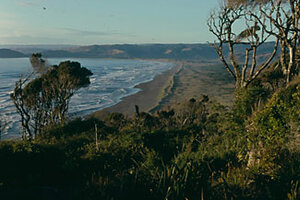Chile or Bust: Tracing the path of the first Americans
New finds from Oregon and Chile support the idea that they arrived 3,000 years earlier than previously thought.

Coming to America: The sandy beaches near Monte Verde in northern Chile. Scientists say some of the Americas' first humans gathered seaweed here.
Tom Dillehay/Vanderbilt University
Half-chewed seaweed in southern Chile and fossilized feces unearthed in an Oregon cave are helping scientists build a case for the arrival of the first migrants in the Americas thousands of years earlier than previously believed.
These archaeological finds – unveiled within the past month – contribute to an evolving story in which the first migrants arrived in the Americas from Siberia between 15,000 and 16,000 years ago. They then appear to have trekked south along the west coasts of North and South America.
Some researchers say the new finds also allow them to begin speculating about social organization, health practices, and how well the newcomers exploited their diverse surroundings.
Several researchers working on the question remain skeptical of the revised picture. Scientific debates over the first appearance of humans in the Western Hemisphere are far from over, acknowledges Ted Goebel, associate director of the Center for the Study of the First Americans at Texas A&M University in College Station, Texas.
But in a recent article surveying the field, he and two colleagues note that the longstanding view that the so-called Clovis culture represents the earliest human occupation of the Americas is getting harder to defend. It would mean rejecting the growing number of sites that appear much earlier, "and this appears to be no longer possible," they write.
For example, scientists working a settlement site in southern Chile have unearthed what they interpret as stone-cutting tools, one of which had small particles of seaweed on the blade, according to research published Thursday in the journal Science.
The site, dubbed Monte Verde II and increasingly acknowledged as the oldest settlement in the Western Hemisphere, lies 55 miles east of the coastline of that time.
The team, led by Vanderbilt University archaeologist Tom Dillehay, found several species of seaweed, including five species they hadn't seen there before. In addition, they found algae that normally grows on trees and rocks along the coast. The seaweed specimens were found in soil from the floors of a what scientists think was a residential and a medicine hut.
The seaweed samples are between 13,980 and 14,220 years old. The oldest Clovis sites, by contrast, are some 13,000 years old.
The finds have some intriguing implications, Dr. Dillehay says. The variety of plant, seaweed, and animal remains found, along with the site's riverside location, suggest that the Monte Verdeans had lived there long enough to develop a detailed understanding of the range of food and medicinal resources available to them from the coast well into the mountains. That could imply that early immigrants moved south far more slowly than some have suggested – coming to terms with their current location before moving to another one.
Just as intriguing, he says, is plant material found, native to Patagonia, on the eastern side of the Andes. "So, they're cutting through the mountains into the dry steppes of Argentina," he says. "That could happen as a result of long foraging trips."
Thousands of miles north, in a cave complex in south-central Oregon, a team led by University of Oregon archaeologist Dennis Jenkins has found evidence of human presence in the area – in the form of fossilized feces. The material dates to between 14,000 and 14,270 years ago – some 3,000 years older than the oldest known human remains tied to the Clovis culture.
The results, which Science published online in early April, include DNA analyses that link six of 14 samples to two "founding" groups of native Americans.
Concerns remain over the possibility that the feces could have become contaminated over the millenniums. Dr. Jenkins says his team went through great lengths to rule out contamination. The team plans additional work at the site and is processing another 24 samples.
Still, the Oregon caves provide an intriguing geographical bookend to Monte Verde, says Jenkins. Both sites imply that people had lived there for some time.
Researchers who still argue that the Clovis people were the first to appear in the Western Hemisphere say that much of the evidence for pre-Clovis cultures is ambiguous. "Too many researchers with different points of view or different standards for interpreting the data disagree about the most basic lines of evidence," says Gary Haynes, an archaeologist at the University of Nevada at Reno.
Clovis – with its distinctive spear points and sites throughout North America – still represents the first widely recognizable culture in the Western Hemisphere, researchers say. And scientists focusing on pre-Clovis sites acknowledge that for them, typical "smoking gun" evidence is harder to come by. Much of the coastal land traversed by pre-Clovis people is now under water, thanks to sea-level rise from melting continental glaciers at the end of the last Ice Age. And the people were on the move.
Pre-Clovis "is kind of a stealth culture," Dillehay says. It lacks a "corporate logo," he adds, such as the Clovis spear points.
